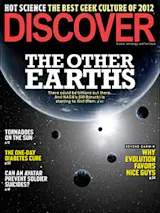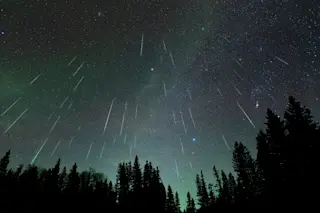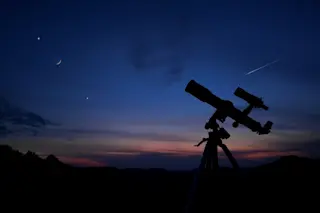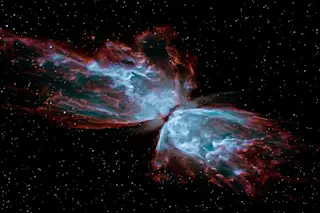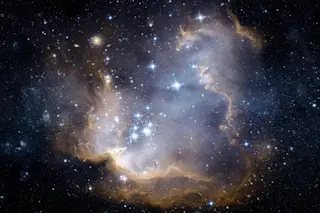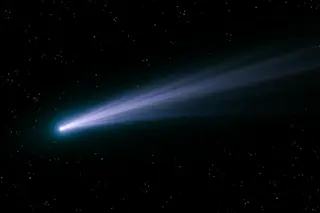In 1992 Bill Borucki presented NASA with an audacious proposal: a space telescope that would detect Earth-size planets quadrillions of miles away. NASA quickly rejected it. After all, nobody knew if there were any planets beyond our solar system. But Borucki, a veteran of the never-say-never Apollo era that put men on the moon, does not give up easily. He spent the next decade building parts and performing experiments to show that his vision could become reality. In 2001 NASA finally caved and approved the Kepler space telescope, with spectacular results. Since its launch in 2009, Kepler has spotted more than 3,000 potential planets and definitively confirmed the existence of over 100, including searing gas giants and eerie worlds with two suns. By 2016, Kepler should start delivering its biggest payoff yet: planets whose size and distance from their stars are very similar to Earth’s. DISCOVER associate editor Andrew Grant caught up with Borucki at his modest office at NASA’s Ames Research Center on a typically pleasant northern Californian afternoon.
What steered you toward the moon and planets? Were you always interested in space? As a boy I was certainly interested in astronomy. My friends and I would bike to Yerkes Observatory, about 15 miles from my hometown of Delavan, Wisconsin. The skies were very dark, so you could just climb up on a roof and watch meteor showers.
Did your interest go beyond observing? My friends and I built rockets. I remember one of our early models: about two inches high, with a little drilled hole where we put gunpowder. Gunpowder was easy to get at in those days—there weren’t terrorists around. After a while our rockets got fairly big. We used steel tubes several inches in diameter, with many pounds of propellant, and radios inside so that we could pick up the signal from them. We’d call the sheriff and tell him we wanted to launch, and he would shut down the roads in the area. The real problem was if the rocket came down and killed a cow. That was a bad thing. You had to pay the farmer for that cow.
So did you ever kill a cow? We never killed a cow.
How did you get started at NASA? After I got a master’s degree in physics at the University of Wisconsin in 1962, NASA was the only place I wanted to work. Two of their labs gave me an offer: the Aircraft Engine Research Laboratory [now Glenn Research Center] in Cleveland and Ames Research Center at Moffett Field, California. Glenn was doing propulsion research; Ames was designing heat shields for the Apollo program. They both looked like good possibilities, but my father told me to go west. I said, “Well, OK. He’s got some wisdom I’ll take advantage of.” So I took the offer from Ames.
How did you get two NASA offers? You must have been an outstanding student. You have to remember that at this point NASA hadn’t gone to the moon. We didn’t know how to build a heat shield to protect a spaceship as it went through Earth’s atmosphere. We didn’t understand the chemistry of the atmosphere that it would have to fly through. There was so much that we didn’t know, so back then you didn’t have to be a straight-A student. You didn’t have to have a Ph.D. Basically, you just had to be able to solve problems, and solve them quickly and in a practical fashion.
Building an effective heat shield was in fact one of your first projects, right? We needed to see what a spacecraft would be facing when coming back through Earth’s atmosphere, so we had to recreate those conditions in the lab. The idea was to have two giant guns pointed at each other—one would shoot 300 pounds of air at Mach 15, and the other would shoot a model of the craft through that air. The friction from a spacecraft going through the air at such high speed creates a luminous shock wave in front of the heat shield. My job was to design equipment that could analyze the light from that shock wave. Those measurements could tell us the chemistry of the heated air and whether the heat shield was effectively protecting the spacecraft.
How do you set up an experiment like that, testing conditions nobody has experienced before? We needed a gun that was almost beyond belief in terms of performance. You can’t shoot that much air that fast out of an ordinary rifle. But Ames had a procurer—a person who got things—and we gave him tough tasks, one of which was to get the guns off a Navy battleship. And so he did. Then we figured out how to screw one gun into another, so one battleship gun fired into the next battleship gun, until we created a giant gun that could fire all that air through a supersonic nozzle. See, at that time we needed to beat the Russians to the moon, before they got there and planted their communist flag. So at NASA there weren’t a lot of impediments. The philosophy was, let’s go and do it, and do it quickly. Today, most the things you want to get have to go through the whole form system, and it costs more to process something than it does just to go out and buy it. Back then we were extremely efficient in many ways. We’re not that efficient today.
What did it feel like when you saw the triumph of the Apollo 11 astronauts on July 20, 1969? Well, it was obviously very special to see them successfully land on the moon, walk on the moon. It was even more special to see them come back alive. That first part was great. Second part was even better.
And then the quick anticlimax, as Apollo ended in 1972. What did you do next? NASA fired everybody who was working on Apollo. So the idea was to find some other job at Ames. It was a matter of going around and saying, “Look, I’ve got lots of talents. What kind of problems do you have that I could help you solve?” I ended up writing some nice papers on Earth’s atmosphere and lightning on Venus, Jupiter, and Titan.
When did you start thinking about a mission to find planets around other stars? Ames has always had seminars by prominent scientists. And in the 1970s, they had seminars about finding planets beyond our solar system. People like [physicist and futurist] Freeman Dyson were quite active in this area. Most of them were interested in trying to find planets through astrometry, measuring the change in the position of stars due to the pull of their planets’ gravity. I didn’t know anything about astrometry, but between my work on heat shields and lightning I did know a lot about photometry —studying the intensity of light. I began thinking that maybe photometry could be another way to find planets. I talked to some of the people in the seminars, but there was no interest. Everyone was convinced the job was going to be done with astrometry.
How did you develop your idea of searching for planets by looking at starlight? Reading the literature was very helpful. I found a 1971 paper in the journal Icarus by a neurosurgeon named Frank Rosenblatt. It was a brilliant paper about how you could find planets around other stars by measuring the light from those stars. If a planet passed between the star and your telescope, you’d see a little drop in the intensity of the light. Unfortunately, just after Rosenblatt submitted the paper he went canoeing on a river and drowned. But Ames astronomer Audrey Summers and I started with Rosenblatt’s paper, made some corrections to it, and then asked ourselves what kind of instrument would be required to take the measurements. In 1984 we wrote a paper concluding that you could detect Jupiter-size planets this way using ground-based telescopes. But to get to much smaller Earth-size planets, you would need a telescope above the distortions of the atmosphere, in space.
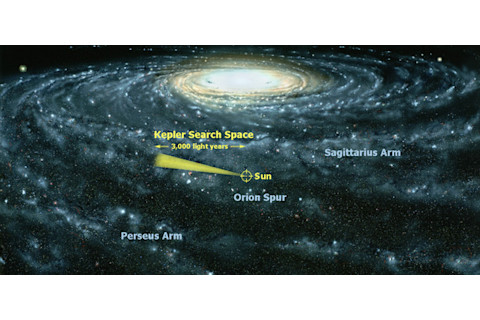
Compared with the vastness of our galaxy, the conical zone that Kepler observes is small—less than 3,000 light-years deep. Extrapolating from Kepler's early finds, our galazy hosts at least 150 billion planets. | Jon Lomberg/NASA/
What did you do then? Somehow you had to turn a general concept into a specific plan. Ames had something called the Director’s Discretionary Fund, a pot of money NASA centers could do what they wanted with. I was reasonably successful at getting small $10,000 or $15,000 grants to run a workshop or build a small photometer to measure brightness. People would come and discuss how to build a really precise photometer. It was almost beyond imagining what was required: A Jupiter-size planet transiting a sun-size star dims the light by about 1 percent, or 10,000 parts per million. But for an Earth-size planet, you need to do 1,000 times better than that—your photometer has to be sensitive down to about 10 parts per million. Little by little we started figuring out how to get down to that precision.
And then you conceived of a spacecraft that could find planets that way? Yes, when you submit a proposal to NASA you have to lay out every component of your instrument. We knew our spacecraft would require a large telescope and light detector that would continuously monitor thousands of stars, watching for the brief planetary transits. By monitoring so many stars, you increase the chances of a transit and you have more statistical power to make estimates about the frequency of planets in the galaxy. From the beginning, this mission was designed to be a survey with the purpose of determining the frequency of Earth-size planets in the habitable zone of their stars: planets that could support liquid water, and maybe life. If the frequency is high, there’s probably lots of life in the galaxy and beyond. If there are very few Earths, then it’s really going to be a bear to find life.
When did you first propose a planet-hunting mission to NASA? It was 1992, and the reviewers quickly rejected it. They said there were no detectors that could make such precise measurements. I believed there were, but I didn’t have the proof yet. We proposed a revised version of the mission two years later, and this time they rejected us because of cost. NASA had just spent over a billion dollars putting the Hubble telescope in space [and had just dealt with the public relations fiasco of its out-of-focus optics]. They were afraid of the cost of another space telescope.
How did you try to change their thinking? By 1996, when there was yet another opportunity to get missions funded, we had made light measurements using charge-coupled devices, or CCDS [similar to the light detectors in digital cameras], and showed that these detectors should be precise enough to find planets. We were also able to point to the discovery in 1995 of the first extrasolar planet orbiting a sunlike star. Another thing we had to do to help seal the deal was name the mission. For the first two proposals it was called the Frequency of Earth-Sized Inner Planets, or fresip. What a wonderful name. I thought of it myself. Everybody else hated it. Carl Sagan [who worked on the project until his death in 1996] and other members of the team said, “Bill, let’s go and change that to something more exciting, like Kepler.” In the 17th century, Johannes Kepler deduced the planetary laws that we depend on to interpret our data. He also established some of the laws of optics that helped people understand how to properly grind lenses for telescopes. I gave in. We changed the name and proposed the mission again in 1996.
And then you got another rejection. Right. Having shown that the detectors worked, having shown that we could fly a mission for less than the cost of Hubble, having changed the name—it still wasn’t enough. NASA said nobody had ever demonstrated that you could track thousands of stars simultaneously with good precision. They said, “Go build an observatory and prove it can be done.” We borrowed a tiny, broken-down old dome with a small telescope at Lick Observatory, 30 miles from Ames. We had to seal the roof and chase snakes and rats from under the floorboards. There was no bathroom, so if we wanted to go at night we had to cross a path where there were mountain lions. But we rebuilt the observatory, built the telescope, and made the measurements. We showed that we could do photometry on 6,000 stars simultaneously. We proposed the Kepler mission again in 1998.
Was the fourth time the charm for Kepler? No—NASA rejected us again. This time they said we needed to show that even in orbit, where it is dealing with cosmic rays and other noise, the telescope would be sensitive enough to detect Earth-size planets. At least they gave us $500,000 to demonstrate this in the lab. Ames came in and lent us another $500,000. NASA headquarters thought it would take us two or three years to design and build this thing. Then we’d miss the next chance for a proposal and go away and get out of their hair.
This time you had to build a prototype yourself, with no “procurer” to help. How did you do it? We built a closet-size device, about 4 feet by 4 feet and 10 feet tall. At the bottom we placed a globe and shined a light in it. The light came out of the globe and through a metallic disk with laser-drilled holes. Each hole represented a star. At the top we put a little telescope and a ccd to detect the brightness of all the stars. Then we jiggled the telescope just like what would happen in space. The hardest part was simulating dips in brightness of 84 parts per million, the amount of dimming caused by an Earth-size planet around a sunlike star. If you just stick a piece of glass in front of one of the holes, it reduces the brightness by 40,000 parts per million. So we had to invent something new. We put very fine wires across some of the holes, and then ran current through the wires. When the wires got hot, they expanded by the diameter of a few atoms and blocked just the right amount of light. With all that in place, we showed that even with vibrations in space, the detectors could make these observations.
NASA figured this would take you a few years. How long did it take for real? We got it to work in six months, sent a technical report to headquarters, and submitted our proposal on time. In January 2000 NASA finally said, “We give up. Here’s your money.” They gave us some funding but told us we were competing against two other missions. Then in 2001 they officially approved us and set a launch date of 2006.
But then you ran into money problems. Right after we got funded, NASA told us we weren’t going to get any money the first year. I was outraged. We had critical people who would leave. Fortunately, Anne Kinney, who was a director of science missions at NASA headquarters, acquired money—from various places we probably don’t want to go into—and gave us $1 million to get started. We ran into another problem in 2005, while we were building things rapidly. NASA informed us six months into the fiscal year that they had cut our budget in half, which means we’d already spent everything we were going to get for the year. Our only option was to fire everybody. Then the next year we had to hire new people and retrain them. That increased the total cost of the mission by many millions of dollars and caused a year of delays.
Despite all that, you had Kepler ready to go in 2009. How was the lead-up to the launch? Kepler was set to launch on a Delta II rocket, and those rockets were having trouble at the third stage. The fuse didn’t work well. Sometimes it would light at the wrong time or not at all. Right before our launch, there were two new Deltas sitting on the pads at Cape Canaveral, one for a military gps satellite system and one for Kepler. The military told us, “You get to launch first. We want to see if the fuse works.”
That must have made you extra nervous. There was some anxiety. But after that many years, you’re pretty used to anxiety.
What was it like watching Kepler finally make it into space after all those years of planning? It was wonderful just to see Kepler go into orbit. But one of the biggest excitements came three or four weeks later, when we saw the full-frame image come in. All the stars were there. The spacecraft was not jiggling. It was just a marvelous image.
OK, time for the nuts and bolts. How does Kepler actually work, hunting for planets? Kepler is like a giant camcorder constantly taking images of a group of about 170,000 stars in one patch of sky. The system takes an image every six seconds and then records the 30-minute average brightness for each star. We store all that data on the spacecraft for a month. Then the spacecraft rotates toward Earth and transmits the data to us.
That sounds like a bewildering amount of information. How do you make sense of it? We analyze the data once every three months. There’s a lot we have to account for: Star brightness readings are affected by temperature changes on the spacecraft and the electronics, and some stars change brightness naturally. So we have to measure all those different processes and cancel them out. Only then can we look for transits, those little brightness dips that indicate planets. We have a computer program search through all the data looking for little repeating dips; repeating means that you are seeing the same planet going around and around. If the program finds at least three potential transits around a particular star at regular intervals, then it flags that star for follow-up.
How many new planets has Kepler discovered around the 170,000 stars you’re watching? The computer has flagged about 15,000 possible planets, but a lot of those are false positives. For example, there are lots of stars that cross in front of each other, which causes a similar dip in brightness. So we get a group of scientists together at Ames to do what we call triage. They glance through all the crossing events and identify the ones that look promising. These are known as “objects of interest,” and they number about 4,000. Then we have another team that looks through this data in a huge amount of detail. If the object passes that test, then we upgrade it to “planetary candidate.” We have identified more than 3,000 candidates, and we believe that most of them really are planets. But we don’t call any of them planets until observers can confirm them.
How do astronomers confirm a planet around another star trillions of miles away? They use ground telescopes to look for the gravitational tug the planet would make on its star. They use space observatories like the infrared Spitzer telescope to confirm the transits. So we execute a whole stack of ground- and space-based measurements, along with some very clever analysis of the data. Only if a candidate passes all those tests do we say it’s a confirmed planet. Once we say we’ve discovered a planet, we will bet our careers that it is a planet. It’s not a false positive. If we say it’s an Earth-size planet in the habitable zone, there is no way mankind knows of anything more we can do to prove it really is a planet.
What does Kepler tell us about the overall number and variety of planets out there? Based on Kepler’s growing planetary candidate list, it is clear that our galaxy contains at least 150 billion planets, and that at least half of its stars have planets. The 3,000 candidates range from well below the size of Mars to nearly double the size of Jupiter. About 1,500 are twice the size of Earth or smaller, meaning they might very well be rocky planets. Most of them are like Neptune: ice giants with lots of rock and ice but also hydrogen and helium atmospheres inhospitable to life. However, we expect that many of these Neptunes have moons. There are several groups looking for these moons, since some could be Earth-size and temperate enough for life.
What are your favorite days working on Kepler? The highlights are the days when I see the rough drafts of papers with the proof—not the speculation, not the hope—that these planets exist. I’ve read things like “We found a planet orbiting a binary star.” For a long time people didn’t believe there could be planets orbiting a pair of stars. We proved they do. I’ve read papers that found small planets with a high density. For sure those are rocky planets, like Earth or Venus. Those papers get me really excited.
While you look for planets, you’ve also been learning a lot about stars, right? In fact, one of the biggest surprises from Kepler is that two-thirds of the sunlike stars we are tracking are quite a bit more variable in brightness than the sun. We don’t understand that. The sun is 4.5 billion years old in a 13.7 billion-year-old universe, so it’s relatively young. We expected most of the stars in Kepler’s field of view to be older, and older stars tend to be quieter and less variable. But we’re finding that most of them are active, so maybe we are looking at younger stars than we thought.
What does that extra variability mean in terms of finding planets? It makes it a lot more difficult to separate the small signal of an Earth-size planet from the natural noise of the star. It means that we’ll need to see more than three transits to discover such a planet orbiting a sunlike star. We’re going to need at least six transits, and I really think closer to eight, to be able to say yes indeed, we are finding Earth-size planets around stars just like our sun.
When do you expect the big announcement: Here it is, another planet just like Earth? Earlier this year NASA gave us a four-year extension through 2016, but Kepler will need another couple of years beyond that to find the most interesting planets. This mission gets more and more valuable every single day that it runs. The data we have now are great, but not as interesting as the data we will get further out. That’s where we’ll be finding lots of planets in the habitable zone—the distance from the star where a planet could support liquid water and potentially life. That’s the big payoff. We’re finding gold dust. If we continue, we’ll find gold nuggets.
You are 73 years old now. Will you still be working with Kepler when it hits its golden era? I could have retired many years ago, and my earnings would probably be higher if I had done that. But this is an opportunity to find the answer: Are Earths common or rare? I’ve worked for 30 years on this, and I really want to see what that answer is. So I’m planning on being around.
Where do we go from here? Even if Kepler finds a world that is just like Earth in size and distance from its star, it can’t explore it in detail. How will we find out if any of those planets are habitable or, more exciting, if they actually have life? Kepler’s job is to look deep into the galaxy and tell us what’s out there. The next missions should look at nearby stars and identify the ones with planets. The European Space Agency is proposing a mission called Plato to do that; NASA has lots of options, such as the Transiting Exoplanet Survey Satellite, though they are not yet funded. After that we have to build a powerful telescope that examines the planets around nearby stars and looks for water, carbon dioxide, and oxygen in their atmospheres—signs that they could support life. That mission is going to be extremely expensive. It will challenge our technology. But it is so important that it will be done.
Is it frustrating to think about how long it will be before we can visit these planets for real? Of course. It still frustrates me just that Kepler launched in 2009 when it was supposed to launch in 2006. But when you talk about state-of-the-art missions, missions that have done things no one has ever been able to do before, delays are typical.
Where do you rank Kepler among all the science missions NASA has done over the years? It’s obvious: It’s number one. There is no mission that’s comparable. Apollo has its own provenance, and I rank it equally with Kepler. Down, way down below, you can see the Hubble Space Telescope, which takes lovely images and tells us about the structure of the universe. That’s interesting, but Kepler is the greatest mission NASA has ever flown.
Kepler 101 How to Find other Earths
1. SUNSHADE
The shade prevents sunlight from tainting Kepler’s measurements. Because it is so close, the sun is about 1015 times as bright as the average star that Kepler monitors.
2. PHOTOMETER
A light detector tracks stars in a field of view the size of 400 full moons. Every six seconds, an onboard computer reads out how much starlight was collected by each pixel.
3. COOLING SYSTEM
Kepler’s sensitive detectors require temperatures of about –120 degrees Fahrenheit to operate. Ammonia and propane flow through small pipes to cool the instruments.
4. SOLAR PANELS
Solar cells provide more than 800 watts of power. Kepler’s orientation remains the same as it orbits the sun, so every three months it must rotate to reposition the panels sunward.
5. ANTENNA
Once a month, Kepler stops observing for a day to beam more than 10 gigabytes of data to Earth. Complex software on the ground analyzes that data to search for signs of planets.
The kepler space telescope is an extremely complicated instrument, but the 2,300-pound observatory’s core function is actually very simple: It is a light collector. The light from about 170,000 stars in the constellation Cygnus enters a 37-inch telescope and feeds into an array of 95 million pixels. Each pixel is like a bucket that collects starlight; the brighter the star, the more starlight each bucket accumulates. Most of the time, the amount of light in each pixel remains constant. Kepler scientists are interested in the brief moments when a star’s brightness dips—the telltale shadow of a planet passing in front.
—Andrew Grant
Kepler’s Top planets
Kepler 47: Strangest Sky Many stars in our galaxy exist in pairs, and astronomers had suspected that the competing pull of two stars would make it difficult for planets to form. Then, in August, Kepler scientists discovered a binary star circled by two planets. One of them, Kepler 47c, is probably a gas giant, but it lies in a region warm enough for liquid water. Perhaps it has a large moon that could support life. At the very least, it has some picturesque double sunsets.
Kepler 36: Most Crowded One of Kepler’s more surprising results is that many stars host multiple planets crammed together in weirdly close orbits. The star Kepler 36 has two planets: an inner rocky world slightly larger than Earth, and an outer gas giant about the size of Neptune. The two planets can approach within 1.2 million miles of each other—one-twentieth the minimum distance between Earth and its closest neighbor, Venus.
Kepler 22b: Most Earth-like This world, announced last December, is twice the diameter of our planet, and its estimated surface temperature is a balmy 90 degrees Fahrenheit. Researchers at the Planetary Habitability Laboratory at the University of Puerto Rico rank it as the most Earth-like of the planets found with Kepler.
Kepler 20: Oddest Family Five planets, including two rocky worlds about the size of Earth, orbit the star Kepler 20. Unlike our solar system, the planetary types alternate: A gas giant is closest to the star, then a rocky planet, then gas, rocky, and gas. More data will determine whether our solar system’s pattern is typical or rare.
Kepler 10b: Kepler’s Calling Card Announced in January 2011, Kepler 10b was the mission’s first discovery of a small, rocky planet, proof of the Kepler telescope’s planet-hunting prowess. Kepler 10b is not a promising spot for life, though: It is so close to its star that its landscape is probably 2800-degree molten rock.
—A.G.
Do-It-Yourself Planet Hunting
It took Bill Borucki more than 30 years and $600 million to build the Kepler telescope so he could detect planets around other stars. Now that he’s done the hard work, anyone can go online and start finding planets in five minutes. Or if you are feeling more ambitious, you can buy an off-the-shelf telescope, tap into the latest digital tools, and begin searching all by yourself. Here’s how.
On Your Computer Begin your adventure at Planet Hunters. In the time it takes to view the latest viral YouTube video, you can sort through Kepler data and identify planets.
Start at the site’s homepage for a brief tutorial. The idea is to look at light curves, graphs that depict the brightness of stars in Kepler’s view. In the rare moments that a planet crosses in front of a star—called a transit—the star’s brightness takes a small dip. All you have to do is identify those dips and draw boxes around them. “Once you know what you’re doing, it shouldn’t take more than 10 seconds each,” says Yale University astronomer Debra Fischer, who launched Planet Hunters in 2010.
The light curve below, for the star KIC 6185331, displays an obvious dip (around day 28). Six participating Planet Hunters flagged that depression, which helped scientists identify a Saturn-size world. The amateurs were coauthors on a related paper in the journal Monthly Notices of the Royal Astronomical Society. More discoveries, and papers with amateurs as authors, are in the works.
In Your Backyard If relying on data from a multimillion-dollar space telescope leaves you unfulfilled, you can observe planets yourself. It costs about the same as a family vacation to Disney’s Space Mountain, and you don’t have to wait on those long lines.
Bruce Gary, a former NASA astronomer who has a small observatory in his Arizona backyard, has written an e-book on amateur planet hunting, available free at brucegary.net. He recommends an 11-inch telescope such as Celestron’s CPC 1100 GPS (about $3,000), a superb-quality camera like the SBIG ST-7 (buy a used model online for about $2,000), and MaxIm DL Pro software ($499, cyanogen.com) to analyze your data. Observe known or suspected planets by referring to a list of transit times published at the Exoplanet Transit Database. Then submit your light curves to ETD, which pools data from amateurs and pros worldwide to nail down the properties of distant planets.
Data from amateurs is important because professionals do not have the time or money to observe every planetary transit at major observatories. In 2005 astronomer Peter McCullough of the Space Telescope Science Institute in Baltimore put out a call for help in observing a suspected planet. Four amateurs, including Bruce Gary, came to his aid. A year later they jointly published a paper announcing a broiling, Jupiter-size planet called XO-1b in the Astrophysical Journal. “You have to be willing to flounder,” Gary says. “But once you’ve tasted success, you can’t not do it again.”


